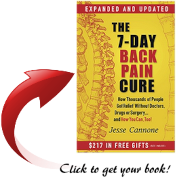I recently attended a seminar on reversing diabetes. No, I don’t have diabetes, but I thought it was worth attending since I know people close to me that have that dreaded disease. I usually don’t spend my Saturdays going to seminars and stuff, but what caught my eye on this one — other than it’s a free seminar — was that it claimed to significantly lower the blood sugar levels of diabetics to normal levels, and at the same time, take them off their diabetic prescription drugs.

What did I get out of that seminar? Well, for starters, that chronic inflammation was the root cause of many dreaded diseases, such as diabetes and chronic pain. It was very hopeful to see that others have jumped on the bandwagon and are seriously taking a look at countering the effects of inflammation. The presenter was a D.C., Doctor of Chiropractic, so it wasn’t that surprising to hear such a presentation like that. I would have loved to see more medical doctors involved in such seminars, but hopefully the topic of treating inflammation will catch on more in the mainstream medical world.
The presenter mentioned the “bad” inflammation as “subclinical inflammation”, but I’ve heard other terms like chronic inflammation as well as systemic inflammation. Another gold nugget from the seminar was the discussion of the hs-CRP lab test. Though it was a very brief discussion, at least the presenter stated that it can tell us how good or bad our inflammation levels are. We can request the test from our primary care doctor, however, the presenter did say that our doctor may not even know how to interpret the results of the test. Unfortunately, he left it at that and did not discuss what indicated a high risk reading from that lab test.
According to the site Lab Tests Online, an hs-CRP (i.e., High-sensitivity C-reactive Protein) lab test can help predict a person’s risk of cardiovascular disease. However, recent medical studies indicate that CRP is a measuring stick of the inflammation level in your body. It also stated that higher levels of inflammation in the body can be associated with other diseases, such as diabetes and chronic pain disorders (i.e., fibromyalgia).
The results of such as test can provide these risk factors:
- Low risk: less than 1.0 mg/L
- Average risk: 1.0 to 3.0 mg/L
- High risk: above 3.0 mg/L
What I didn’t like about the seminar was that it tried to use the fear factor in getting the attendees to buy into their product/program by presenting comparisons that showed how dangerous certain foods were. For example, one of the presentations showed a typical bowl of cereal (of a famous household brand), and how that one bowl of cereal needed to be complemented by 25 (or some other crazy number of) bowls of salad to counter the inflammatory effects of that one bowl of cereal. To me, that example is highly flawed since we really don’t know what that bowl of salad consists of. Sure, if it was only ice berg lettuce and a few cherry tomatoes, then perhaps you need to eat a ton of salad to protect you from it. However, what if the bowl of salad contained kale, spinach, and broccoli … all inflammation fighting veggies? I’m sure the 25 bowls of salad will be reduced significantly. Nevertheless, I thought the seminar provided helpful information to the masses, and hopefully, drove the idea to them that chronic inflammation is dangerous, however, we can counter it with the proper anti-inflammatory foods. Of course, regular exercise and getting 7 hours of sleep are other components to help counter chronic inflammation.




